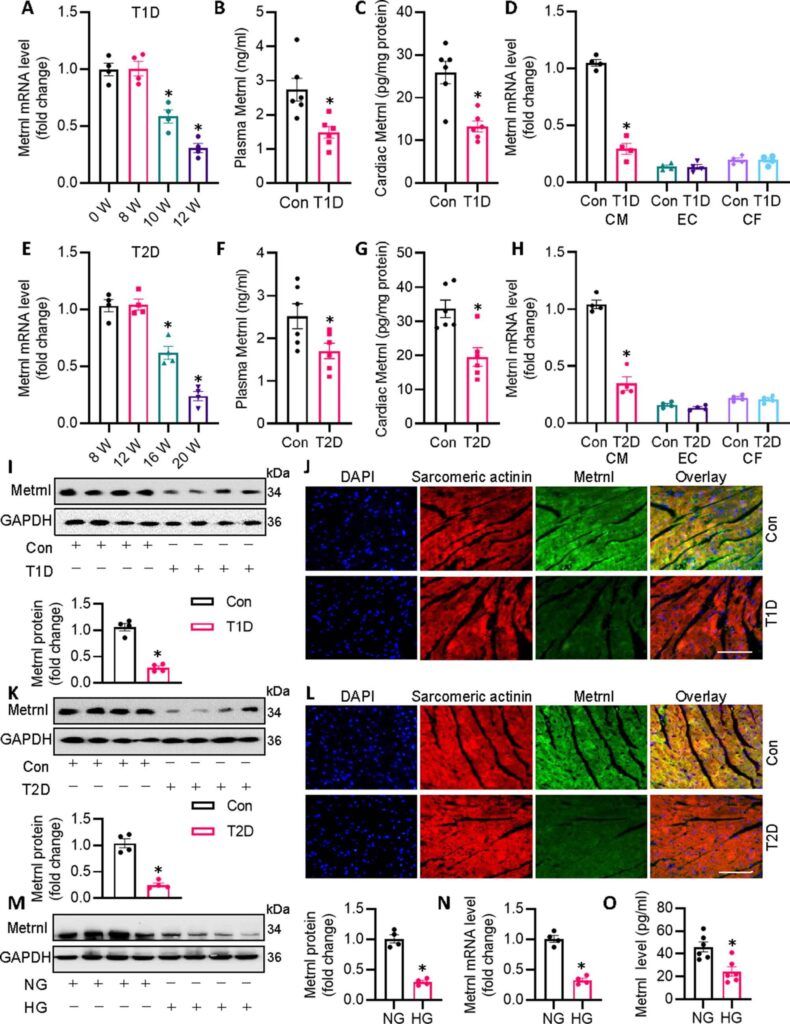FineTest Elisa kit contributes to the research on diabetic cardiomyopathy treatment. The immunoassay is designed to measure Metrnl concentration in cardiomyocyte supernatant.
Publication Details
Article Title: Metrnl ameliorates diabetic cardiomyopathy via inactivation of cGAS/STING signaling dependent on LKB1/AMPK/ULK1-mediated autophagy
Journal Title: Journal of Advanced Research
DOI: 10.1016/j.jare.2022.10.014
IF: 12.822
PMID: 36334887
Abstract: Introduction: Meteorin-like hormone (Metrnl) is ubiquitously expressed in skeletal muscle, heart, and adipose with beneficial roles in obesity, insulin resistance, and inflammation. Metrnl is found to protect against cardiac hypertrophy and doxorubicin-induced cardiotoxicity. However, its role in diabetic cardiomyopathy (DCM) is undefined. Objectives: We aimed to elucidate the potential roles of Metrnl in DCM. Methods: Gain- and loss-of-function experiments were utilized to determine the roles of Metrnl in the pathological processes of DCM. Results: We found that plasma Metrnl levels, myocardial Metrnl protein and mRNA expressions were significantly downregulated in both streptozotocin (STZ)-induced (T1D) mice and leptin receptor deficiency (db/db) (T2D) mice. Cardiac-specific overexpression (OE) of Metrnl markedly ameliorated cardiac injury and dysfunction in both T1D and T2D mice. In sharp contrast, specific deletion of Metrnl in the heart had the opposite phenotypes. In parallel, Metrnl OE ameliorated, whereas Metrnl downregulation exacerbated high glucose (HG)-elicited hypertrophy, apoptosis and oxidative damage in primary neonatal rat cardiomyocytes. Antibody-induced blockade of Metrnl eliminated the effects of benefits of Metrnl in vitro and in vivo. Mechanistically, Metrnl activated the autophagy pathway and inhibited the cGAS/STING signaling in a LKB1/AMPK/ULK1-dependent mechanism in cardiomyocytes. Besides, Metrnl-induced ULK1 phosphorylation facilitated the dephosphorylation and mitochondrial translocation of STING where it interacted with tumor necrosis factor receptor-associated factor 2 (TRAF2), a scaffold protein and E3 ubiquitin ligase that was responsible for ubiquitination and degradation of STING, rendering cardiomyocytes sensitive to autophagy activation. Conclusion: Thus, Metrnl may be an attractive therapeutic target or regimen for treating DCM.
Keywords: Diabetes, Cardiomyopathy, Metrnl, AMPK, Autophagy, STING
Immunoassay
| FineTest Product | Sample | Detection Target | Species |
| Rat Metrnl(Meteorin-like protein) ELISA Kit(ER0675) | supernatant | Metrnl | Rat |
Validated Image

Figure Source: J Adv Res. 2022 Nov 8;S2090-1232(22)00243-0. doi: 10.1016/j.jare.2022.10.014.
Fig. 1. Metrnl is downregulated in diabetic mice.
